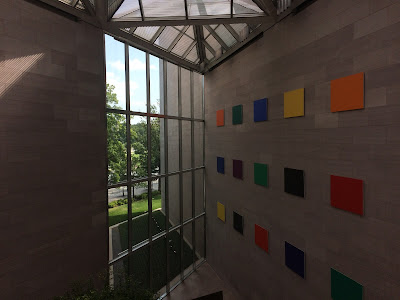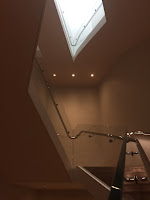One of my favorite aspects of being back in school has nothing to do with school at all but rather the wonderful city that is just a few metro stops away.
Washington D.C. has been a regular destination for me since I started going to college. It started with a trip to the Folger Shakespeare Library for an assignment, and since then I've made regular trips, both for class and leisure. One of the places I had yet to visit was the East Building of the National Gallery of Art. While I've explored the West Building many times through - though I still haven't managed to get through the whole thing - the East Building was completely new territory.
Despite being there for the art, it's difficult to not enjoy the building itself. A parti diagram of it would likely be a bunch of triangles interacting with each other in a variety of ways. Very early on in my architectural studies, I was told by a colleague to avoid corners under 90* because it usually leads to wasted space. Thus far, I've avoided these small corners, but the East Building makes a wonderful use of them.
There are absolutely a number of wonderful moments within the building . . .
. . . including a Barcelona Pavilion style seating area with direct views to the West Building. I can never not give a shout out to Mies.
But, enough of the building. Onto the art. We first encountered Capricorn (1975) by Max Ernst. It made me wonder what a Sagittarius sculpture might look like.
Horse (1914) by Elie Nadelman.
I'm not sure who the artist was or what the work was called, but these animals were quite fun to look at. Photographing them was a bit difficult, but that's to be expected.
Of course, the infamous Rothko. He had a full exhibition on the upper level. This is Orange and Tan (1954), though my favorite of his is No. 61 (1953).
Up the spiral stairs, we found The Minor Arts, an exhibition by Theaster Gates that focuses on everyday crafting. The most notable element of the exhibition was New Egypt Sanctuary of the Holy Word and Image. It reminded me greatly of the current free library trend.
Also included was Something about Modernism and Death . . .
. . . as well as The Ax . . .
. . . and my personal favorite, A Game of My Own.
The Minor Arts is a wonderfully analytical exhibition that I certainly don't have the time to delve into outside of the aesthetics, but I do encourage you to look into the concept itself.
The most profound work I saw was also one that I couldn't remember the title of, and no amount of Googling "painting with van gogh and dancing skeletons" has given me a result.
My friend described this painting as one that gets increasingly discomforting the more you look at it. In my opinion, she's not wrong, but I actually quite like it. The exchange is a little reminder that conceptual pieces are rarely good or bad but simply up to interpretation.
Washington D.C. has been a regular destination for me since I started going to college. It started with a trip to the Folger Shakespeare Library for an assignment, and since then I've made regular trips, both for class and leisure. One of the places I had yet to visit was the East Building of the National Gallery of Art. While I've explored the West Building many times through - though I still haven't managed to get through the whole thing - the East Building was completely new territory.
Despite being there for the art, it's difficult to not enjoy the building itself. A parti diagram of it would likely be a bunch of triangles interacting with each other in a variety of ways. Very early on in my architectural studies, I was told by a colleague to avoid corners under 90* because it usually leads to wasted space. Thus far, I've avoided these small corners, but the East Building makes a wonderful use of them.
There are absolutely a number of wonderful moments within the building . . .
. . . including a Barcelona Pavilion style seating area with direct views to the West Building. I can never not give a shout out to Mies.
But, enough of the building. Onto the art. We first encountered Capricorn (1975) by Max Ernst. It made me wonder what a Sagittarius sculpture might look like.
Horse (1914) by Elie Nadelman.
I'm not sure who the artist was or what the work was called, but these animals were quite fun to look at. Photographing them was a bit difficult, but that's to be expected.
Of course, the infamous Rothko. He had a full exhibition on the upper level. This is Orange and Tan (1954), though my favorite of his is No. 61 (1953).
Up the spiral stairs, we found The Minor Arts, an exhibition by Theaster Gates that focuses on everyday crafting. The most notable element of the exhibition was New Egypt Sanctuary of the Holy Word and Image. It reminded me greatly of the current free library trend.
Also included was Something about Modernism and Death . . .
. . . as well as The Ax . . .
. . . and my personal favorite, A Game of My Own.
The Minor Arts is a wonderfully analytical exhibition that I certainly don't have the time to delve into outside of the aesthetics, but I do encourage you to look into the concept itself.
The most profound work I saw was also one that I couldn't remember the title of, and no amount of Googling "painting with van gogh and dancing skeletons" has given me a result.
My friend described this painting as one that gets increasingly discomforting the more you look at it. In my opinion, she's not wrong, but I actually quite like it. The exchange is a little reminder that conceptual pieces are rarely good or bad but simply up to interpretation.
















Comments
Post a Comment